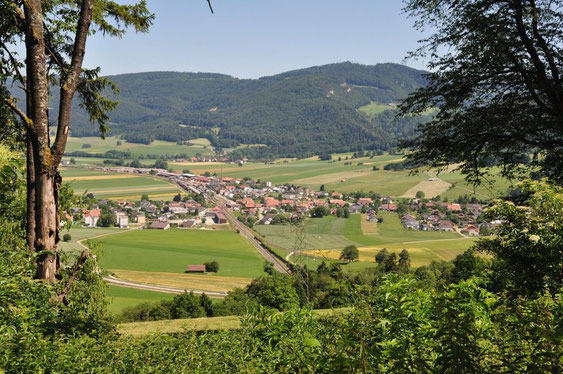Deep Geothermal Pilot Project in Haute-Sorne (JU)
Facts & Figures
Location: Haute-Sorne
Canton: Jura
Project type: Geothermal power plant for electricity production
Status of work:
- 2012: Decision on location and start of project development
- 2012 - 2015: Project planning, extensive investigations, information events, work of the advisory group
- May 2015: Establishment of Geo-Energie Jura SA, based in the municipality of Haute-Sorne
- June 2015: Third-party liability insurance with a sum insured of CHF 100 million
- June 2015: Obtaining the building permit for a geothermal pilot power plant with two deep wells and a power plant; appeal against the building permit by 5 neighbours
- June 2015: signing of a tripartite agreement between the municipality of Haute-Sorne, the canton and Geo-Energie Suisse. This agreement governs in particular the licence fees for electricity generation, the status of the operating company and the establishment of an information commission for the implementation of the project
- July 2016: popular initiative launched for a general ban on medium-depth and deep geothermal energy in the canton of Jura
- December 2016: the administrative court rejects the appeal against the construction permit
- January 2017: the appellants refer the court decision regarding the construction permit to the Federal Court
- February 2017: the federal government issues a risk guarantee
- July 2017: the popular initiative is submitted to the canton
- November 2017: the Parliament validated the initiative. This decision is contested by two appeals.
- November 2017: following an earthquake in Pohang in South Korea, the causes of which were linked to the construction of a geothermal power plant nearby, the Jura government asked Geo-Energie Suisse to provide a report on these events and their consequences for the Haute-Sorne project.
- July 2018: the cantonal administrative court declared the popular initiative to be invalid, and the initiators decided not to appeal to the Federal Court.
- December 2018: the Federal Court ruled that the appeals were definitively rejected and that the special land-use plan was in force.
- January 2019: Submission of an in-depth report to the government of the Jura canton following the earthquake in Pohang (South Korea) with findings for a geothermal project in Haute-Sorne. The government commissions the Swiss Seismological Service (SED) to review the report and make recommendations for the further development of the Haute-Sorne project.
- September 2019: The federal government supports the Haute-Sorne geothermal project in the canton of Jura with a CHF 64.1 million exploration grant (media release dated 11 September 2019).
- October 2019: The Swiss Seismological Service (SED) presents its expert report to the Jura government.
- April 2020: The Jura government publishes the SED report. The report confirms that the Haute-Sorne project meets the prescribed requirements and planned risk management and sees no reasons not to proceed with the project. Nevertheless, the government announces that it will initiate a procedure that could ultimately lead to the cancellation of the permits.
- June 2020: The federal government increases its contribution to the exploration of the Haute-Sorne project from 64 million francs to 90 million francs. This gives the project a double safety net.
- January 2022: The Canton of Jura makes a positive decision in principle regarding the Haute-Sorne deep geothermal energy project. With additional safety requirements, the pilot project can be realised.
- June 2023: Geo-Energie Jura SA continues the testing and validation of seismicity measuring instruments, which began in February 2023.
- July 2023: a seismic reflection campaign is carried out in the second half of July to recognise the geological structure of the subsoil over a depth of several hundred metres and thus optimise the planning of the exploration drilling planned for spring 2024.
- October 2023: work on the future drilling site in Glovelier begins at the end of the month.
- November 2023: the first geothermal power plant is built in the US state of Nevada, applying the multi-stage stimulation concept developed by Geo-Energie Suisse AG. This plant supplies electricity to a Google data centre.
- April 2024: a second 2D seismic reflection campaign is conducted on profiles with a total length of around fifty kilometres. This campaign has provided images of the subsoil down to the planned drilling depth.
- May 2024: drilling begins. Drilling is expected to continue until September 2024.
- August 2024: the target depth of 4000 metres is reached. The various analyses carried out show that the geological structures encountered correspond more or less to the forecasts. The work has not caused any water or air pollution, no influx of fluids, no loss of mud, no radioactive pollution, and no seismicity.
- January 2025: a campaign to acquire 3D geophysical data was carried out in a 30 square kilometre area around the borehole. The aim was to refine the knowledge of the subsoil obtained through the 2D seismic reflection campaigns of July 2023 and April 2024.

